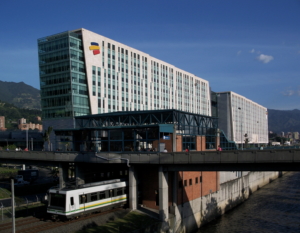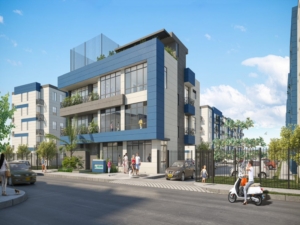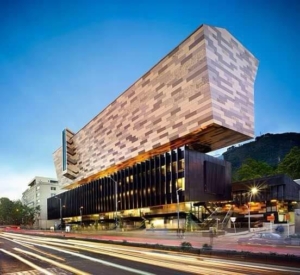Stories
Colombia: Green Buildings Accelerate from Zero to 20 percent of the Market in Four Years
Serving as a model for Latin America, the construction sector in Colombia has transformed towards a green buildings future in only in a few years.
The construction sector in Colombia has transformed towards a green buildings future in only in a few years. A combination of government incentives, the support of a strong local partner and technical assistance to developers, alongside innovative green finance offerings acted as a catalyst to create a thriving ecosystem for the green housing market.

Feeling is a hotel housing project located in Medellin, Colombia.
The country’s progress serves as a model for Latin America: as of September 2021, the nation has 5.9 million square meters of certified green space either constructed or in progress and close to 73,000 green homes, of which two thirds are affordable housing. The International Finance Corporation (IFC) estimates that over 20% of new builds were certified green in the year to July 1, 2021.
A sustainable construction policy articulated with the private sector
In 2015, the national government enacted a Green Building Code and soon after introduced tax incentives for technical solutions such as insulation and energy-efficient air conditioning systems. Assisted by IFC, the Colombian government encouraged a progressive application of sustainable construction practices through the GB Code. Tax incentives for energy efficiency were introduced to facilitate the financial viability of these new practices, a policy that was welcomed by the private sector.
In 2017, IFC started working with the Colombian Chamber of Construction (CAMACOL) to promote EDGE certification as a tool to a provide a clear path for the Colombian construction sector to implement sustainable practices. An innovation of IFC, EDGE provides a platform for designing and certifying green and Zero Carbon buildings. CAMACOL spearheaded an aggressive agenda to provide training and capacity building to its members to use EDGE.
“Having such an efficient and committed partner for EDGE was truly a game changer. Colombia owes the transformation of its construction sector in large part to the visionary leadership of CAMACOL” commented Corinne Figueredo, Global Manager for the Green Building Program at IFC.
The partnership between CAMACOL and IFC delivered outstanding results as EDGE certification experienced an unprecedented growth in Colombia, reaching records in certified floor space and market penetration heretofore unseen elsewhere in the world.
The financial sector responded

Headquartered in Medellín, Bancolombia was first bank in Colombia to issue a green bond.
Colombia’s green building code was the first mandatory code in Latin America for new residential and commercial developments. The code raised awareness of green solutions and helped energize the market for sustainable building projects in need of funding.
In 2016, Bancolombia became the first bank in Latin America to issue a green bond in the amount of COP 350 billion ($115 million) to finance green buildings; a bond in which IFC invested. The bank provided loans for green construction financing at between 0.5 percent and 2 percent less than conventional market rates by using its own resources alongside the proceeds of the green bond. The more measurably green the project was, the better the financing rate.
Bancolombia and Davivienda, another IFC client, were the two first banks in the region to issue green bonds, with subsequent sustainable issuances in the primary market. Their efforts began to transform the green building and green finance market throughout Latin America, and other banks quickly followed
In 2021, there are five commercial banks in Colombia offering green financial products in the construction sector (including Bancolombia, Davivienda, BBVA, Banco Bogotá and Caja Social), which makes it one of the most empowering financial environments for green building investment in the region. Banking has accelerated green building market transformation by encouraging all business segments and project sizes to add EDGE certification to their projects.
The results to date
In just four years and despite the ongoing COVID-19 pandemic, IFC estimates that EDGE certified floor space now exceeds 20 percent of new construction and represents a cumulative private sector investment of more than $5.9 billion. More than 73,000 housing units have been EDGE certified nationwide, and two thirds are low-income, affordable housing. Taking into consideration that a low-income family can spend up to 15 percent of their monthly income in utility costs, reducing these costs by offering more efficient housing is a significant achievement for the country.
“The EDGE certification is a success in Colombia because it addresses three essential components of sustainability: proven environmental impacts, leveraging green financing and contributing to the social welfare of those who need help most” commented Sandra Forero, President of CAMACOL.
Training more professionals in designing buildings with greater efficiencies
Edificio Jorge Hoyos Vasquez is an EDGE Advanced (Zero Carbon Ready) building on the Pontificia Universidad Javeriana campus in Bogotá.
In 2020, IFC signed License and Cooperation Agreement with Pontificia Universidad Javeriana and Universidad de la Salle to offer the “Design for Greater Efficiencies” course which was created with input from ETH Zurich. This course aims at training future architecture and engineering professionals with a vision to design and build edifications that are efficient with the planet’s natural resources. It is expected that each university will train 45 professionals each year.
What’s next – Municipal incentives for sustainable buildings
To achieve compliance with the Paris Agreement, new buildings must be Net Zero Carbon in their operations by 2030, and existing buildings by 2050. While recent progress is encouraging, a lot more remains to be done. Despite the green growth of the construction sector in recent years, sustainable buildings have yet to be consolidated as a general practice in all territories. For this reason, IFC and CAMACOL, with the support of the of the Ministry of Housing, City and Territory, the National Planning Department, and the Colombia Green Building Council (CCCS), are joining forces to achieve the creation of incentives that will help push the nation towards total carbon neutrality.



